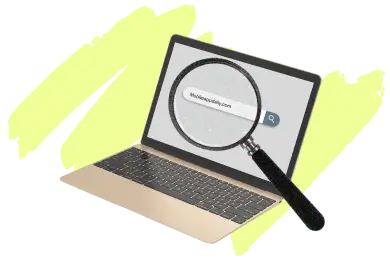
- The IoT Insights & Facts
- IoT on the Horizon: Prospects and Potential
- The Unstoppable Rise Of The Internet Of Things: What's Behind It?
- Navigating The Complexities Of The Next Generation of IoT
- The Benefits of IoT: Unlocking Value Across Industries
- Internet of Things 2030 Potential Economic Value
- Industrial Impact of IoT: Disrupting Traditional Business Models
- The IoT Paradigm Shift: Unpacking B2B vs. B2C Dynamics
- IoT Tailwinds And Headwinds
- What It Takes To Scale The IoT?
- Where and How to Capture IoT Value in the Coming Decade?
- The Crux: Conclusion: Navigating the IoT Gold Rush - Where and How to Strike It Rich
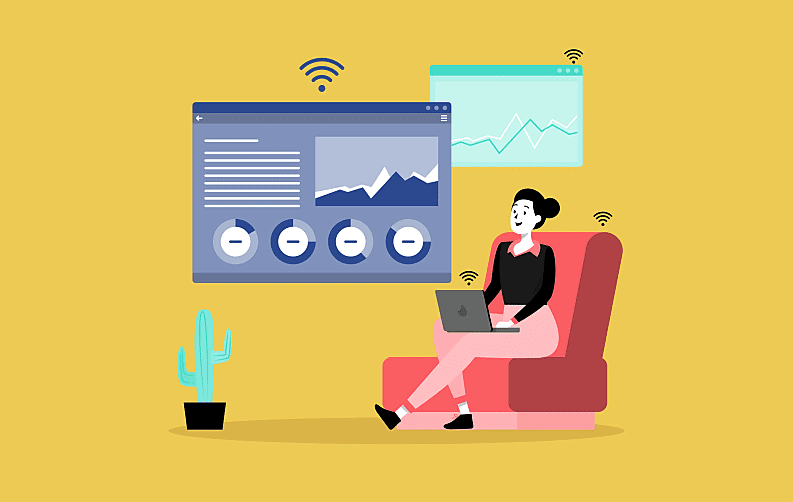
The convergence of the digital and physical worlds, known as the Internet of Things (IoT), has emerged as one of the basic trends powering the digital transformation of business and the economy. From the fitness trackers we wear to the smart thermostats we use in our homes to fleet-management solutions that tell us when our packages will arrive to sensors that promote increased energy efficiency or monitor natural disasters caused by climate change, the Internet of Things is now embedded in consumers' lives as well as the operations of businesses and governments.
Lower power chips, improved connection, advanced artificial intelligence (AI), and machine learning (ML) are enabling novel Internet of Things (IoT) application cases today. Applications in healthcare, manufacturing, and transportation are becoming increasingly popular. According to McKinsey research, IoT devices and services will be worth between $5.5 trillion and $12.6 trillion by 2030.
To fulfill the potential of IoT, industry leaders must agree on standards that will unify device makers and manufacturers. IoT goods, software, hardware, and chip makers — whether partners or competitors — must work together to develop new features, products, and innovations and bring them to market as quickly as possible.
In this researched blog, we will look at the predicted growth determinants, the tangible benefits across industries, and the strategic measures needed to capitalize on the huge potential of IoT in the future decade. Join us on this illuminating journey as we analyze what is Internet of Things revolution is and reveal where and how to capitalize on the opportunities it brings.
The IoT Insights & Facts
The Internet of Things (IoT) is changing how things are done today and pointing us in an interesting new direction. Its quick spread throughout commercial activities has increased productivity and efficiency. Globally, consumer acceptance of IoT is increasing, especially in smart homes. These developments portend a time when smart buildings and houses will be the norm, transforming connection and boosting productivity.
The Internet of Things (IoT) shapes our current reality as we enter the digital era and point us toward a fascinating future.
The IoT revolution continues rapidly in today's growing digital transformation, from data-driven smart cities to intuitive houses that adapt to our requirements. We are on the verge of a revolutionary future in 2023 as IoT powers myriad commercial endeavors.
As per the report of Gartner, the number of IoT-connected devices is estimated to increase to $43 billion by 2023. The rapid proliferation of IoT devices, facilitated by advancements in connectivity solutions such as fifth-generation wireless connectivity (5G), has fundamentally changed how businesses operate, opening avenues for improved efficiency, productivity, and decision-making. This signals a transformation for the present and sets the stage for future enterprises.
The global market for the Internet of Things (IoT) was estimated to be worth around 182 billion dollars in 2020, and it is anticipated to reach more than 621 billion dollars in 2030, triple its current size at that time. Additionally, the number of Internet of Things (IoT) connected devices is anticipated to triple globally during this time.

IoT on the Horizon: Prospects and Potential
One of the most revolutionary technical developments of the twenty-first century is expected to be the Internet of Things (IoT). IoT is a network of networked devices expected to fundamentally alter industries, lifestyles, and economies as we learn more about its potential applications.
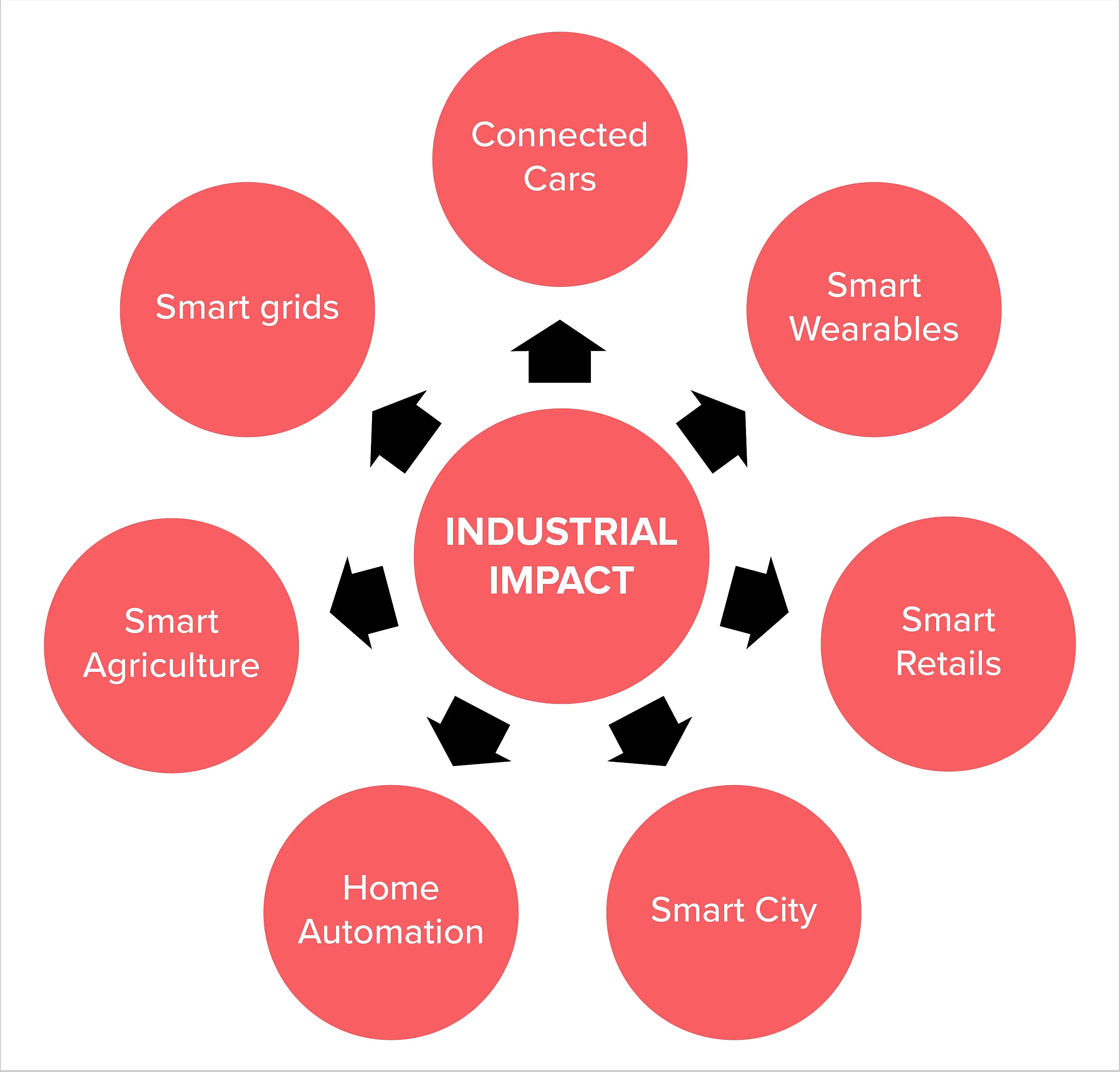
1. Transforming Industries
IoT is an industry-wide change facilitator. Real-time data analytics and IoT-enabled sensors are streamlining production lines in the industrial sector, cutting down on downtime and increasing productivity. This leads to cost reductions and raises the caliber of the final product. 80% of businesses have included IoT in their daily operations.
Precision farming and other IoT uses in agriculture transform crops' growth while increasing yields and conserving resources. Real-time tracking capabilities of IoT help logistics and supply chain management, assuring smoother operations and prompt deliveries. IoT-enabled remote patient monitoring in the healthcare industry also strengthens patient care, lowers healthcare expenses, and boosts general well-being. Several industries use the best and top 10 platforms to pick for IoT development.
2. Consumer Convenience
The IoT's effects go beyond businesses and industries. It has crept into our homes, enhancing the comfort and connectivity of daily living. IoT-enabled smart homes enable homeowners to remotely control lighting, heating, security, and entertainment systems. Assistive technologies like voice-activated assistants, intelligent refrigerators, and connected appliances are becoming increasingly prevalent, making our homes more effective and responsive.
3. Urban Innovation - Smart Cities
Smart city development is driven by IoT. These cities have IoT sensors that monitor trash management, energy use, traffic movement, and air quality. These data-driven insights help cities allocate resources more efficiently, lessen their negative effects on the environment, and improve the quality of life for their citizens.
Some of the prominent effects of IoT in urban planning include smart transportation systems, public safety measures, and effective public services. The size of the global IoT in smart cities market was $110.56 billion in 2020 and is anticipated to increase from that amount to $582.38 billion by 2028, with a CAGR of 23.3%.
4. Data as the New Currency
The data produced by linked devices is at the heart of IoT prospects. This data is a priceless resource that can be used to obtain knowledge, make wise choices, and develop new business strategies. Businesses are spending money on data analytics to glean useful information from this massive data set, opening the door to innovations and competitive advantages. The business sector is now witnessing the Internet of Things (IoT) and its impact on app development.
The Unstoppable Rise Of The Internet Of Things: What's Behind It?
| Drivers of IoT Growth | Key Industries Driving Growth |
|---|---|
| Enabling Technologies | Chips, Connectivity, Security, Artificial Intelligence |
| Increased Expectations | Home, Office, City Environments |
| Smaller, More Efficient Components | Consumer Appliances, Cars, Manufacturing, Human Health |
| Improved Networks | Enhanced Reliability and Feasible Applications |
| Demonstrated Value | Increasing Demand for IoT Solutions |
Industry, commercial, and consumer needs are guiding IoT innovation. As new use cases are made possible by technical advancements, a few main industries are propelling the expansion of connected devices. By 2030, factories and human health will account for 36% to 40% of the expected unlocked value, for instance, predicts McKinsey.
Chips, connections, security, and artificial intelligence are the four IoT-enabling technologies continually developing to lower prices and enhance goods. Nowadays, many anticipate that connected devices will improve their daily activities at home, at work, and when moving about the city.
With smaller, more effective CPUs and wireless components, connected devices will be able to increasingly enter key sectors such as consumer appliances, cars and transportation, manufacturing and industry, and human health. With the help of improved networks, formerly impractical uses are now possible. As linked devices show their value, demand rises.
Navigating The Complexities Of The Next Generation of IoT
Even though the industry appears to be growing, many businesses have struggled to make IoT scenarios live up to their potential. Even though $1.6 billion in value had been created by 2020, that was still at the low end of the market that McKinsey had predicted five years earlier. More recently, Forrester calculated that the pandemic-related chip scarcity has resulted in a 10%–15% decline in growth for the IoT market.
IoT product manufacturers still have serious technological issues as they try to catch up. These include regulating power usage, investigating novel connectivity options, integrating intricate product components, and handling the data these devices generate.
In terms of connectivity, advances in bandwidth accessibility have made IoT helpful in environments with lots of data, including video doorbells and security cameras. However, growth in IoT device deployment and overall device count may result in new connectivity and latency challenges.
Even the hotel and food industry is getting innumerable benefits from the IoT advancement. This is one of the reasons that businesses are keen to learn how IoT can boost your food and restaurant business.
Although tens of thousands of devices may be supported by wireless technology, network congestion will become a problem as IoT devices proliferate. It is now important for businesses to learn how marketers use IoT apps to increase efficiency in 2023.
The Benefits of IoT: Unlocking Value Across Industries
The IoT technology is more than just a technological trend; it’s also a transformative force that can unveil immense value across sectors and industries.Here, we’ll dive into some major advantages IoT technology brings to different industries, highlighting how it’s reshaping business and processes:

1. Enhanced Efficiency and Productivity
The way the Internet of Things affects productivity and efficiency may be one of its major advantages. For example, IoT-capable sensors and devices are integrated into equipment and production lines in the manufacturing business. These sensors continuously monitor various parameters, such as pressure, temperature, and the state of the apparatus.
By using this information, manufacturers might improve output, reduce downtime, and streamline processes. Predictive maintenance is made possible by IoT data, helping to prevent unanticipated equipment failures and saving both time and money.
The agriculture industry has changed due to IoT sensors and data analytics-assisted precision farming techniques. Farmers can monitor crop health, weather patterns, and soil conditions in real-time. Granular data allows for precise irrigation, fertilization, and insect control, which boosts agricultural output while using fewer resources. One of the key advancements to learn is how is IoT in weather technologies being helpful.
2. Data-driven decision-making
Organizations can use the quantity of data generated by IoT for data-driven decision-making. Wearable technology and remote monitoring programs are used in healthcare to collect and instantly communicate patient data to healthcare professionals. There is no doubt that today, there are innumerable advantages of IoT in the healthcare industry that have led to great advancements.
It is possible to identify health problems early, create individualized treatment programs, and provide better patient care thanks to this constant flow of information. The results are improved, and hospital readmissions are decreased when doctors make better-educated recommendations.
| Industry | Benefits of Data-Driven Decision-Making |
|---|---|
| Healthcare |
|
| Logistics |
|
| Retail |
|
| Manufacturing |
|
| Smart Homes |
|
IoT tracking solutions offer real-time visibility into the flow of commodities in logistics and supply chain management. Companies can use this information to streamline routes, shorten transportation times, and react quickly to interruptions. Additionally, providing precise stock levels and lowering the possibility of stockouts or overstocking improves inventory management.
3. Cost Savings and Resource Optimization
IoT technologies have the potential to cut costs significantly across various industries. IoT devices provide real-time monitoring and management of energy use in the context of energy management. Smart HVAC and lighting systems automatically change based on occupancy and environmental factors, lowering operational costs and energy waste.
Building management systems powered by IoT in the construction and real estate industries increase the effectiveness of heating, cooling, and lighting, resulting in lower energy costs. Predictive maintenance of building infrastructure also reduces unplanned repairs and increases equipment longevity.
4. Enhanced Customer Experiences
The Internet of Things (IoT) is transforming how companies engage with their customers, and one of its most important advantages is improved customer experiences. Companies can gather real-time data on customer behavior, preferences, and needs by deploying IoT devices and sensors. With this data, businesses may more accurately adapt their goods and services, resulting in more attentive and individualized client encounters.
IoT also enables proactive issue resolution by spotting prospective issues before impacting customers, raising overall satisfaction levels. Predictive maintenance, for instance, helps ensure that goods are delivered on schedule by preventing equipment breakdowns that could interrupt the supply chain. In addition, IoT makes it possible for smart devices to anticipate user needs, such as altering the climate control in a home or recommending relevant products when shopping online. IoT enables companies to design smooth, effective, customized consumer experiences that increase loyalty and spur company expansion.
5. Safety and Security
IoT guarantees security and safety in various scenarios. For instance, smart cities use IoT to more efficiently manage emergency response times, monitor traffic flow, and detect accidents. Traffic lights that are IoT-enabled alter in real-time based on the flow of traffic, easing congestion and enhancing safety. As per Market Watch, IoT security is estimated to increase at a CAGR of 26.36%, with the market predicted to reach $3.35 billion in 2022 and $13.6 billion by 2028.
IoT sensors can identify dangerous situations in the industrial sector and launch prompt actions, defending workers and averting accidents. IoT-enabled medical equipment can transmit notifications during crises, ensuring quick access to medical care.
Internet of Things 2030 Potential Economic Value
| IoT Setting | Economic value of IoT in 2030 | Key Factors Driving Value |
|---|---|---|
| Factory Setting | $1.4 trillion to $3.3 trillion (26% of total) | Optimization of Manufacturing Operations: IoT technologies can streamline manufacturing processes, reducing costs and increasing efficiency. This includes asset management, predictive maintenance, and supply chain optimization. |
| Improved Asset and People Management: IoT enables better tracking and utilization of physical assets and human resources within factories, further enhancing productivity. | ||
| Enhanced Quality Control: IoT sensors can monitor and maintain product quality, reducing waste and rework. | ||
| Human-Health Setting | $0.5 trillion to $1.8 trillion (14% of total) | Health Monitoring and Improvement: IoT applications in healthcare involve monitoring and improving individual health. This includes connected devices for chronic disease management, remote patient monitoring, and preventive health measures. |
| Increased Consumer Awareness: Growing consumer awareness of IoT healthcare solutions, including wearable health devices, has driven demand and adoption. | ||
| Accelerated by COVID-19: The pandemic has accelerated the use of IoT solutions in healthcare, especially for remote patient care and virus containment. |
The Internet of Things (IoT) has emerged as a significant force ready to change the interaction between the physical and digital worlds, with significant ramifications for society and the global economy. Its potential advantages could be used to improve operational effectiveness, manage physical assets, and advance health and well-being, among other things. IoT is the throbbing center of digital transformations, transforming industries and lives in this dynamic environment.
Classifying IoT according to particular contexts or domains is necessary for analyzing its economic worth. It's crucial to categorize the influence of IoT in terms of various locations or settings to comprehend how it creates economic value. By doing this, we can evaluate its potential advantages and contributions in each situation.
1. Factory Setting as a Leading Contributor
The factory setting is positioned to deliver the most significant economic value through IoT, with projections indicating that it will produce $1.4 trillion to $3.3 trillion by 2030, or 26% of the entire IoT value. Specifically, by improving production activities, factories are anticipated to be a key generator of IoT value. Economic advantages include improved asset management, greater operational effectiveness, and more efficient human resource management.
2. IoT's Impact on Manufacturing Operations
Optimizing daily production activities is the main source of value creation in a factory setting. IoT technology enables the manufacturing process optimization within factories. This entails streamlining supply chain operations, predictive maintenance to stop breakdowns, and real-time equipment monitoring. Increased effectiveness and cost savings are the results of these changes.
3. Human-Health Setting's Economic Potential
IoT impacts human health, with a projected economic contribution of between $0.5 and $1.8 trillion by 2030, or 14% of the IoT value.Remote patient monitoring, managing chronic diseases, and taking preventive health measures are just a few of the many uses for IoT in healthcare. These programs increase healthcare effectiveness and outcomes, which generates financial value.
Healthcare IoT solutions have grown in popularity and usage over the past five years. The perceived worth of IoT solutions in the healthcare industry has significantly increased. This covers mass-market systems for tracking physical activity and connected devices like glucose and heart monitors for managing chronic diseases.
Several reports have been issued on how IoT improves patient compliance in the healthcare industry, leading to a huge demand for adopting the technology.
Industrial Impact of IoT: Disrupting Traditional Business Models
The Internet of Things (IoT) adoption is undergoing a seismic upheaval in traditional corporate structures across many industries. IoT challenges established paradigms by enabling real-time decision-making, gathering data, tying devices, and creating new opportunities. Below, we'll go into more detail regarding how the Internet of Things impacts corporate operations in the industrial sector.
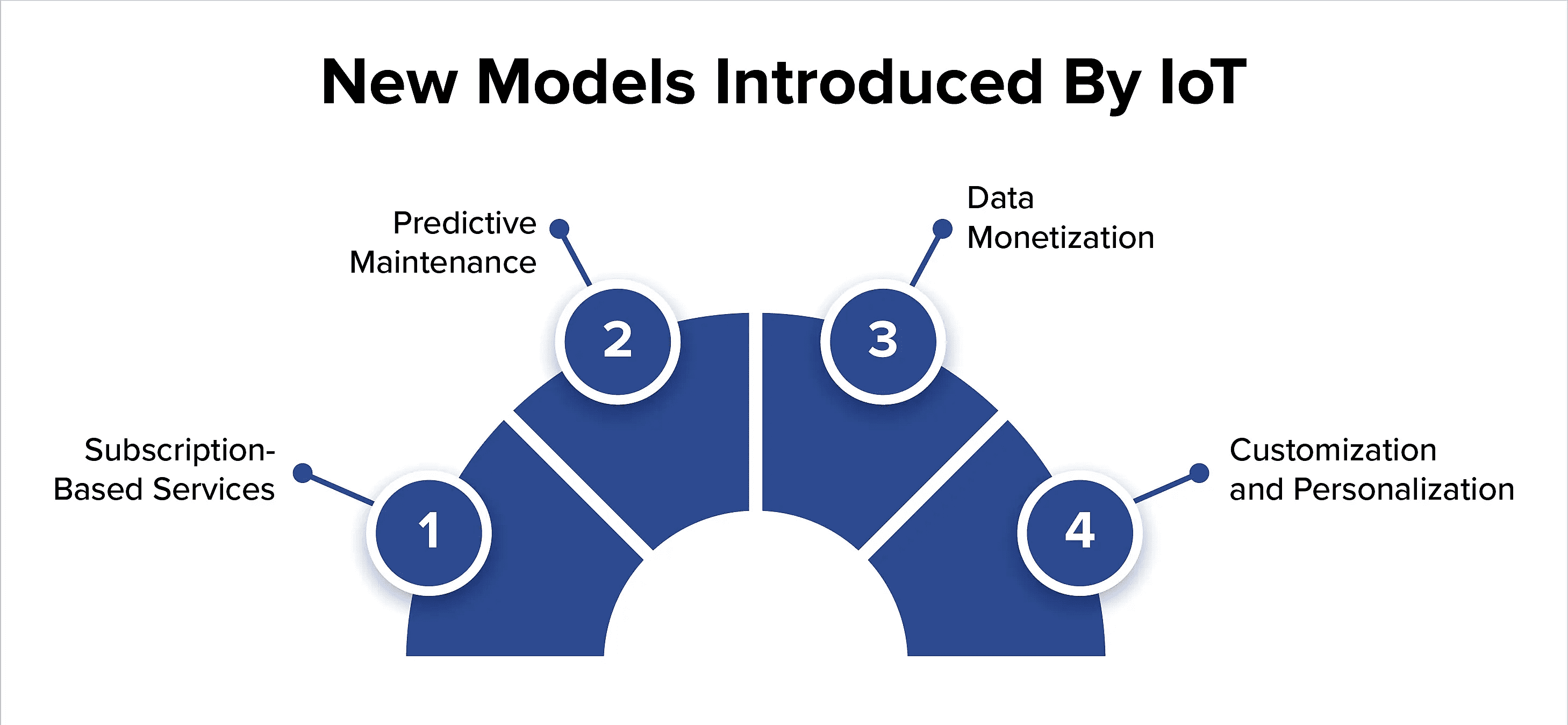
1. Subscription-Based Services
One of the largest disruptions IoT brings is the shift away from product-based business models and toward subscription-based services. According to Deloitte, 69% of homes now utilize one or more subscription video streaming services. Companies are becoming aware of the potential for IoT-enabled devices to provide ongoing revenue streams and strengthen client connections.
For instance, instead of merely selling cars, automakers are increasingly offering connected car services. These services can be purchased via subscription-based business models, including over-the-air updates, enhanced infotainment, and remote diagnostics. As one-time purchases are transformed into regular revenue, it enhances financial stability and enables continued innovation and client involvement.
2. Predictive Maintenance
IoT has changed how expensive and necessary equipment is maintained in manufacturing, aviation, and energy industries. According to a Deloitte analysis, organizations that use predictive maintenance can reduce maintenance costs by up to 40%, reduce downtime by 70%, and improve overall equipment effectiveness (OEE) by 25% to 30%. Predictive maintenance also has the potential to cut maintenance expenditures by up to 25%.
Reactive maintenance has traditionally been used by businesses, meaning they wait until a piece of equipment breaks before fixing it. This tactic frequently resulted in costly downtime and major interruptions.Sensors make Predictive maintenance possible, and IoT makes data analytics possible. These systems include anomaly detection, maintenance predictions, and real-time equipment monitoring.
Businesses can improve operating efficiency, decrease downtime and maintenance costs, and enhance the lifespan of valuable assets by converting from reactive to predictive maintenance. Moreover, companies have started to witness the IoT in app development and how to leverage it in your business.
3. Data Monetization
IoT generates enormous amounts of data, which is important in and of itself. Many businesses seek methods to monetize their IoT devices' data by selling it to outside parties. For instance, smart cities collect data on energy use, air quality, and traffic patterns. Before providing this information to marketing firms, researchers, or urban planners, they can gather and anonymize it.
This information is extremely useful for making educated decisions, enhancing city operations, and concentrating on advertising. Monetizing data gives the business models and revenue streams additional dimensions. Moreover, the Internet of Things and its potential in the banking industry has recently seen an astonishing surge.
4. Customization and Personalization
IoT enables businesses to modify their products and services in response to the preferences of certain customers. Retail uses IoT sensors and beacons to track real-time customer behavior and preferences. After that, this data is used to provide customers with tailored shopping experiences, such as sending pertinent offers or recommendations to their mobile devices while they are in-store.
This level of customization increases customer satisfaction, promotes loyalty, and could increase sales. Catering to individual interests is increasingly becoming a competitive advantage in several industries.
The IoT Paradigm Shift: Unpacking B2B vs. B2C Dynamics
The business-to-business (B2B) and business-to-consumer (B2C) application environments for the Internet of Things (IoT) are different, and this has prompted us to look into it. The information underpins a fascinating narrative depicting the adventures of the two IoT components.
| Aspect | B2B Applications | B2C Applications |
|---|---|---|
| Value Creation Potential | About 70% of the potential for value creation in the IoT is represented by B2B solutions. These programs are geared toward streamlining commercial and industrial operations. | B2C applications comprise a lesser portion of the IoT value creation despite their rapid growth. This is mostly due to consumer adoption of home automation and other smart home technology. |
| Projected Share in 2030 | By 2030, B2B applications are anticipated to continue dominating the IoT market, accounting for 62% and 65% of its value. | Even though they are expanding, B2C applications will still represent a smaller percentage of the IoT market by 2030, accounting for 35% to 38% of the total value. |
| Economic Impact | By 2030, it is predicted that B2B apps will have a large economic impact on the IoT economy, with estimates ranging from a low of $3.4 trillion to a high of $8.1 trillion. | Although prominent, B2C applications are anticipated to have a lower economic share due to their emphasis on consumer-focused solutions. |
| Key Focus Areas | Efficiency, process improvement, and industrial automation are frequently prioritized in B2B IoT applications, reducing costs and boosting productivity. | Smart home appliances, wearable technology, and personal health monitoring are examples of B2C IoT applications that improve consumer convenience and lifestyle. |
| Diverse Opportunities | B2B IoT covers various sectors, including manufacturing, logistics, healthcare, and agriculture, and presents various innovation and value-generation opportunities. | Although B2C IoT is more concentrated in the consumer space, it is still growing as new smart home and personal device categories appear, offering tech corporations and entrepreneurs various opportunities. |
An intriguing finding from a recent study is that over 70% of the overall value potential of IoT is represented by B2B solutions or those designed to enhance business operations and industrial processes. An illustration of how the B2C industry has expanded dramatically concurrently is the growing adoption of IoT in our homes (see home automation and smart devices).
Intriguingly, this dynamic interaction lays the foundation for the following prediction: By 2030, B2B applications are anticipated to dominate the IoT market, representing 62% to 65% of the entire IoT value. In the economic context, this translates to an astounding $8.1 trillion at the high end and roughly $3.4 trillion in the more conservative scenario. Furthermore, the future trends in the IoT interface design have also changed the dynamics of the economic potential.
This change emphasizes the IoT's ability to revolutionize industries, positioning it as a key factor in fostering innovation, efficiency, and economic growth in various sectors. The distinction between B2B and B2C applications illustrates the variety of opportunities and ramifications this integrated digital world offers as we navigate this IoT revolution.
With the advent of 5G technology, businesses today have started to take an interest in developing their apps and websites as per the new trends. But, with the advance of the 5G and IoT revolution by 2025, many prospects are yet to be unlocked.
IoT Tailwinds And Headwinds
Even though the IoT has significant and growing economic potential, tapping this promise has proven difficult. According to the most recent research, the total value realized in 2020 ($1.6 trillion) will be at the lower end of the range of the upcoming future trends. Overall, both the low- and high-end scenarios are less expensive than the initial 2015 estimates: the potential economic value of the IoT in 2025 ranges from $2.8 trillion to $6.3 trillion, against $3.9 trillion to $11.1 trillion from the analysis.
1. Tailwinds
Three main factors are spurring a material acceleration in the adoption of and impact from IoT solutions today:
| Factors | Tailwinds for IoT Adoption |
|---|---|
| Perceived Value Proposition | Customers understand IoT's significant contribution to accelerating digital transformations and sustainability initiatives, with $1.6 trillion in economic value expected to be generated by 2020. |
| Technology | Scalable IoT deployments have been made possible by improvements in affordable technology, including sensors, computational power, storage, and battery life. Deeper insights and automated decision-making are derived from sensor data with improved analytics, AI, and machine learning. |
| >Networks | With the rapid rollout of 5G and the extension of 4G networks, various connectivity choices are now available to meet various needs regarding capacity, speed, latency, and dependability. |
- Value proposition as perceived: Customers now recognize the true value of IoT deployment, which is a substantial improvement.The digital changes and sustainability initiatives underway in businesses and public institutions worldwide have the IoT at their center. The IoT's capacity to offer value at scale is demonstrated by the $1.6 trillion in economic value it will generate by 2020.
- Technology: Technology has advanced remarkably during the last five years. Scale deployment is made possible for most IoT use cases by inexpensive technologies. Visual, audio, and other types of sensors now span the whole spectrum, processing is more than enough, storage is widely available, and battery life has increased. In addition to major advancements in hardware, advanced analytics, AI, and machine learning have also evolved, allowing for faster, more precise insights and automated decision-making from sensor data. Plus, companies can learn how to use VPN to secure IoT based devices and apps.
- Networks: Networks serve as the IoT's skeleton and enable all of its functionality. Fourth-generation (4G) networks from telecom firms have expanded to cover more people at higher performance levels, and 5G networks are being quickly installed. When advancements in other network protocols are matched, customers now have access to a wide range of connectivity alternatives that can satisfy their needs, whether related to capacity, speed, latency, or reliability.
2. Headwinds
The news is not all favorable for the at-scale adoption and impact of IoT solutions. Five factors are acting to dampen both areas overall (again, with some variations across specific settings):
| Factors | Headwinds for IoT Adoption |
|---|---|
| Change Management | Organizations frequently ignore governance, talent, and process reforms in favor of viewing IoT as a technology project rather than an operational transformation to realize value at scale. |
| Interoperability | Lack of a single IoT operating system results in fragmented, proprietary ecosystems, which are problematic for organizations and governments wanting to remove system barriers at scale. |
| Installation | Installing IoT solutions at scale is very expensive due to interoperability issues that necessitate customization and complexity in connecting and integration processes. |
| Cybersecurity | Growing IoT security issues necessitate thorough integration across all technological stack tiers to guard against flaws and potential intrusions. |
| Privacy | IoT deployments become more complex due to increased privacy awareness by laws like the CCPA and GDPR, which force businesses to balance protecting customer data with promotions or discounts. |
- Change management: Companies and governments frequently approach the Internet of Things (IoT) as a technology project instead of an operating model change. As a result, they could be directed by IT without taking necessary adjustments to governance processes, talent, or performance management into account. Cross-functional actors must work together to transform people's behavior, systems, and processes, as well as implement strict performance management, to realize the full potential of the IoT.
- Interoperability: IoT operating systems that are widely used are still a long way off. Instead, the IoT landscape has several exclusive "walled garden" communities. Many businesses and public-sector organizations struggle to scale without extensive IT work to surpass the multiple system hurdles.
- Installation: Ask consumers, business clients, or governments, and many will name installation as one of the most significant financial obstacles to the wide-scale adoption of IoT technologies. Almost every at-scale deployment involves customization, if not a unique solution, due to interoperability issues. At-scale implementation is discouraged by the complexity of actions that appear to be simple, such as obtaining secure connectivity, updating outdated devices, and integrating into current systems.
- Cybersecurity: IoT cybersecurity is a growing concern for consumers, business clients, and governments due to the growing number of connected endpoints that hackers can use. Security must be incorporated throughout every stack layer and from the ground up to address this difficulty.
- Privacy: Privacy is becoming a major concern for many customers because of the passage of the California Consumer Privacy Act and the General Data Protection Regulation of the European Union. Businesses are debating what customers are prepared to forgo in exchange for reduced costs or exclusive offerings in a retail environment.
What It Takes To Scale The IoT?
How can the IoT market live up to its potential? The whole research, The Internet of Things: Catching up to an Accelerating Opportunity, contains implications for suppliers, consumers, investors, and policymakers. Let's start by examining what it will take for IoT enterprise clients to succeed.
Companies that have deployed IoT successfully follow seven main steps:
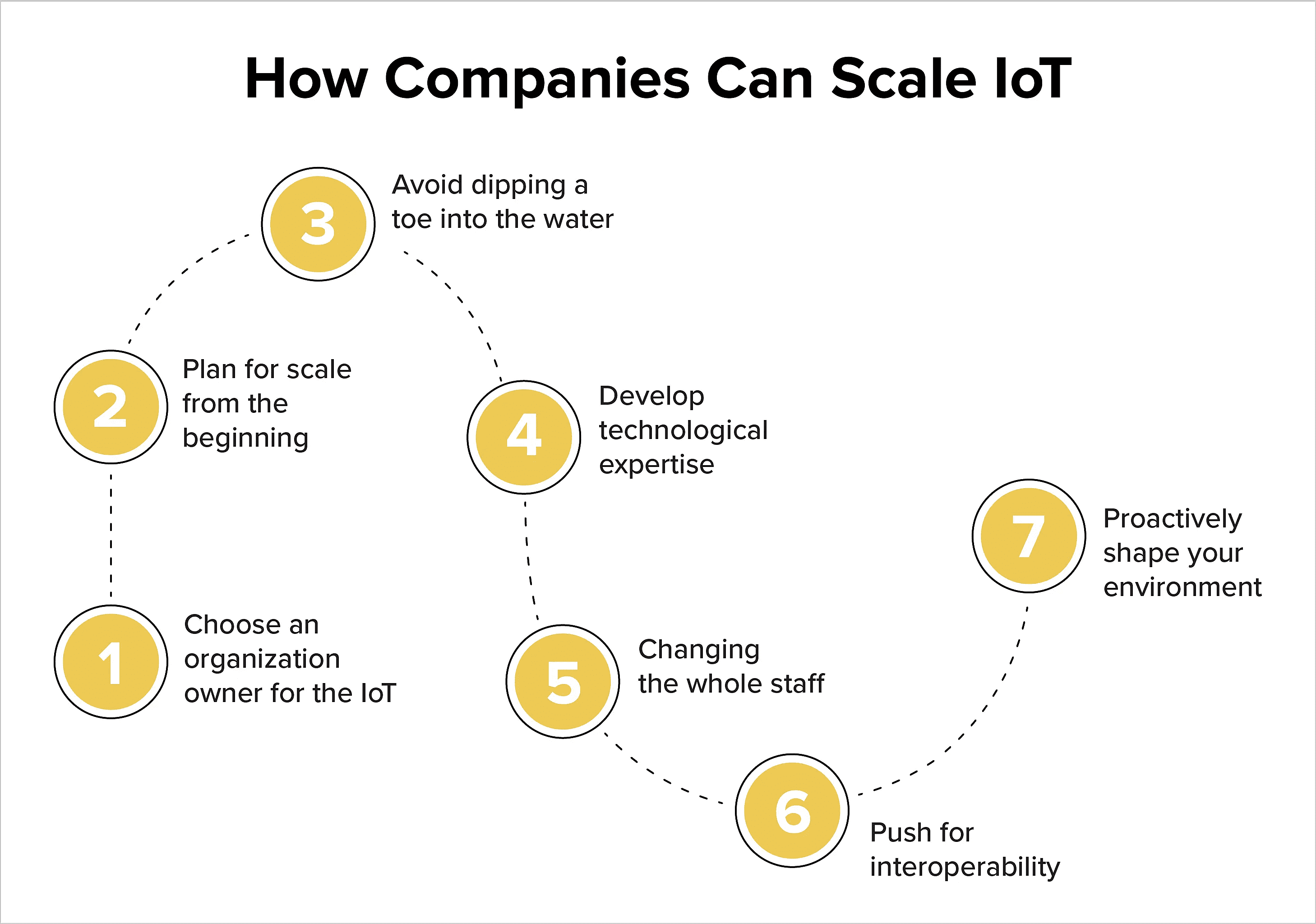
- Choose an organization owner for the IoT: Many firms now lack a single owner for the IoT, with decision-making being spread across several levels, business divisions, and activities. The solution used by businesses that have successfully adopted the IoT at scale is to designate a clear owner (who may originate from several activities and roles).
- Plan for scale from the beginning: The IoT needs to be based on commercial success. Too frequently, business clients are preoccupied with technology while ignoring everything else. The result is evident in the "pilot purgatory" that many business clients experience.
- Avoid dipping a toe into the water: There is no one-size-fits-all use case, notwithstanding the concentration of economic value in particular IoT environments and use-case-cluster combinations. Firms must alter their operating models, procedures, and processes to achieve value capture when deploying many use cases simultaneously.
- Develop technological expertise: Technical skill for IoT is scarce. Hiring recruiters who can traverse the environment and speak the technical language is a first, crucial step in closing the gap. While hiring data engineers and scientists is crucial, firms must also upskill their present data science workforces to stay on the cutting edge.
- Change not only the IT department but the entire organization: IoT implementations are sometimes mistaken for IT department technological projects rather than strategic business changes. Technology alone will never be sufficient to fully realize the potential of the IoT and enable optimum value capture. Instead, the company's process and fundamental operating model must be altered.
- Push for interoperability: Fragmented, proprietary, supplier-specific ecosystems dominate the IoT environment. Even while it works well inside the ecosystem, this strategy has scaling and integration limitations, which reduces the impact of IoT deployments and raises expenses. Corporate buyers can demand interoperability from suppliers as a requirement for their products, and demand vendors support the smooth integration of various use cases, solutions, and providers.
- Proactively shape your environment: Businesses should carefully plan and manage their IoT ecosystems. For instance, creating end-to-end security requires prioritizing cybersecurity from the outset and starting with the hardware layer. Working with reliable suppliers helps lessen the possibility of a breach, but it can be much more effective to implement a cybersecurity risk-management framework that includes not only technical solutions but also business processes and procedures tailored to a company's environment and needs.
[Also Read - Top 10 Internet Of Things Technology Trends Prediction for 2023 by Gartner]
Where and How to Capture IoT Value in the Coming Decade?
The Internet of Things (IoT) is anticipated to see a large development spurt by 2030, when there are expected to be billions of connected devices. This presents a substantial opportunity for businesses in numerous areas. If businesses are to capitalize on IoT's value in the coming decade successfully, they must carefully place themselves in key locations and use the appropriate strategies. Here is a detailed analysis of where and how to benefit from IoT:

1. Investing in IoT Infrastructure
Investing in a strong IoT infrastructure is one of the key steps in capturing IoT value. This includes the following elements:
| IoT Infrastructure Components | Key Considerations |
|---|---|
| Hardware |
|
| Connectivity |
|
| Data Storage and Processing |
|
- Hardware: Businesses should buy and use IoT gadgets and sensors appropriate for their use cases. These include wearables, smart sensors, and networked machinery, among other things. Hardware purchases must be expandable and flexible enough to meet changing demands.
- Connectivity: The method of connection is important. Businesses should choose the best connectivity solutions for their IoT applications as 5G is deployed and low-power, wide-area networks (LPWANs) emerge. The connection infrastructure must support data transmission that is dependable and secure.
- Data Storage and Processing: An efficient data storage and processing strategy is necessary to realize the value of IoT. The enormous amounts of data produced by IoT devices are frequently stored, analyzed, and managed via edge computing and cloud platforms. Organizations should plan data architecture to be flexible and scalable.
2. Data Strategy and Analytics
The real value of IoT data comes from the insights and useful intelligence that can be gleaned from it, not just the data itself. Utilizing this potential
| Aspect | Key Points |
|---|---|
| Data Analytics Capabilities | For insights from IoT data, invest in cutting-edge techniques like machine learning, AI, and predictive analytics. |
| Real-Time Analytics | Use real-time analytics to make quick decisions, particularly in the manufacturing, logistics, and healthcare industries. |
- Data Analytics Capabilities: Organizations should spend money on cutting-edge data analytics tools and technology. IoT data can be analyzed using machine learning, artificial intelligence, and predictive analytics to improve decision-making.
- Real-Time Analytics: Real-time analytics are necessary for some IoT applications to react quickly to shifting circumstances. In industries like manufacturing, logistics, and healthcare, this is essential. Process optimization and increased productivity can be achieved by implementing real-time analytics technologies.
3. Security and Privacy
Security and privacy problems increase with the IoT ecosystem. It's crucial to protect IoT devices and the data they produce:
| Aspect | Security and Privacy |
|---|---|
| Device Security | Implement robust security controls at the device level, such as encrypted data and secure boot procedures. |
| Network Security | To safeguard the integrity and confidentiality of data, secure IoT networks with firewalls, intrusion detection systems, and network segmentation. |
| Compliance | Establish clear privacy policies and processes for user permission and data deletion to ensure compliance with data privacy laws (such as the GDPR and CCPA). |
- Device Security: Implementing strong security measures at the device level is essential. This includes secure boot processes, firmware updates, and data encryption in transit and at rest.
- Network Security: Organizations should secure their IoT networks against threats, ensuring data integrity and confidentiality. Firewalls, intrusion detection systems, and network segmentation can help safeguard IoT networks.
- Compliance: IoT data often involves personal or sensitive information. Adhering to data privacy regulations, such as GDPR or CCPA, is critical. Organizations should establish clear privacy policies and mechanisms for user consent and data deletion. Companies should also learn how technology can help you manage compliance better.
4. Collaboration and Partnerships
IoT frequently involves intricate ecosystems with many players. Organizations should consider the following to properly capture IoT value:
| Aspect | Description |
|---|---|
| Collaboration | Utilize knowledge, cost-sharing, and synergy by working with companies, startups, or IT suppliers. expands the market and speeds up innovation. |
| Standardization | Embrace industry standards for IoT devices and systems. Ensure interoperability to facilitate compatibility, integration, and collaboration. |
- Collaboration: Organizations can acquire complementary skills, split development expenses, and investigate synergistic potential by working with other companies, startups, or technology providers. These collaborations can hasten market penetration and innovation.
- Standardization and Interoperability: Adopting industry standards and ensuring that IoT systems and devices communicate is crucial. Standardization encourages compatibility and simplicity of integration, lowering entrance barriers and promoting collaboration.
The Crux: Conclusion: Navigating the IoT Gold Rush - Where and How to Strike It Rich
Businesses are at a critical crossroads as we prepare for the IoT explosion, which is expected to pick up steam by 2030. The Internet of Things offers a wide range of disruptive potential, but it also needs strategic planning and proactive investment.
Organizations must develop strong infrastructure, invest in data analytics, prioritize security and privacy, look for successful collaborations, and develop IoT expertise to realize IoT's enormous value fully. The key to success is combining these components into a coherent approach that can change the IoT landscape with mobile app development. We all are aware of how are mobile app development companies impacting IT industry in 2023, and there is no doubt that it’s not going to stop.
The IoT revolution represents a significant change in how industries function, not just a technology wave. Those who have the guts to innovate and use IoT's potential will stay ahead of the curve and completely reshape their respective industries. The road to IoT riches may be long and arduous, but the rewards are limitless for those who set out on it with grit and purpose. The IoT gold rush has started, and those who seize it will be rewarded with success.
Frequently Asked Questions
-
What are the key areas where IoT value is expected to accelerate by 2030?
-
How can organizations capture IoT value in these areas?
-
What role do partnerships play in accelerating IoT value?
-
Why are standardization and interoperability vital in IoT value capture?
-
How can organizations prepare for IoT value capture beyond 2030?
















